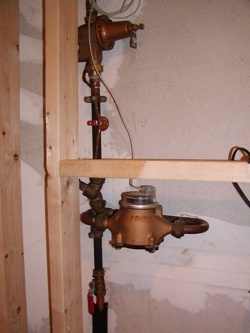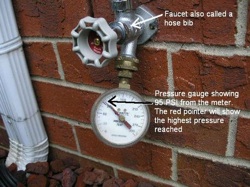Blog Post
Pressure Reducing Valves Save Water and Prevent Problems

Pressure-reducing valves, an element of EPA’s WaterSense® new homes specification, are green: they can save water, increase the service life of plumbing system components, and reduce risks of water leaks.What is a Pressure Reducing Valve (PRV)?PRVs have spring-loaded diaphragms that resist the incoming pressure of the water supply to a home. They are typically installed just after the water meter on the system side (see top photo: This basement photo, starting from the bottom, shows the insulated incoming water main, the single-throw main shut-off (red handle), the water meter, and the pressure reducing valve (set screw stem sticking out to the right). PRVs usually come set at 45 pounds per square inch (PSI) but have a set-screw adjustment so that the PRV’s range of operation is from approximately 30 to 80 psi. PRVs cost around $80; installation costs may double the total cost, depending on installation circumstances (new or existing home, location of incoming line, ease of shutting off water service to the home, etc.). Why are PRVs included in the WaterSense new homes specification?The 2009 WaterSense Single-Family New Home Specification requirement (http://www.epa.gov/watersense/docs/home_finalspec508.pdf) is for static water pressure no greater than 60 psi. For homes with wells, a pressure tank must be installed as part of the domestic water system. For homes on municipal water distribution systems, you need either a PRV or a determination the home complies with the static pressure maximum (see the Inspection and Verification Guidance for WaterSense® Labeled New Homes - http://www.epa.gov/watersense/docs/home_inspection-guidelines508.pdf .
PRVs save water by reducing flow rates. The greater the water pressure, the greater the rate of flow for many plumbing fixtures. Reducing the system pressure by as little as 10 to 20 psi can save thousands of gallons a year in a typical home. Reflecting this benefit, it is not uncommon for PRV installations to be supported by water utilities. The City of Austin’s water utility gives a $100 rebate for PRV installations in homes with greater than 80 psi water pressure (http://www.ci.austin.tx.us/watercon/prvrebate.htm).
But PRVs in homes with high water pressure are green and smart for other reasons. Many residential plumbing fixtures are engineered for pressures no greater than 75–80 psi; some manufacturers void their warranties if pressures are above this range. Fixtures such as storage-type water heaters, dishwashers, refrigerator icemakers, and pressure-assisted toilets can be particularly prone to reduced service life or leaks at pressures above 75–80 psi.
Is high water pressure really that common?
It’s easy to test your water pressure—you can screw a pressure gauge right on to a hose bib (see bottom photo). If pressures exceed 200 psi, two PRVs can be installed in series to manage the load. But leave the installation of the PRV to a plumbing professional, hopefully a green one (http://www.greenplumbersusa.com/).
SUPPORT INDEPENDENT SUSTAINABILITY REPORTING
BuildingGreen relies on our premium members, not on advertisers. Help make our work possible.
See membership options »Published June 24, 2010 Permalink Citation
(2010, June 24). Pressure Reducing Valves Save Water and Prevent Problems. Retrieved from https://www.buildinggreen.com/blog/pressure-reducing-valves-save-water-and-prevent-problems



Add new comment
To post a comment, you need to register for a BuildingGreen Basic membership (free) or login to your existing profile.